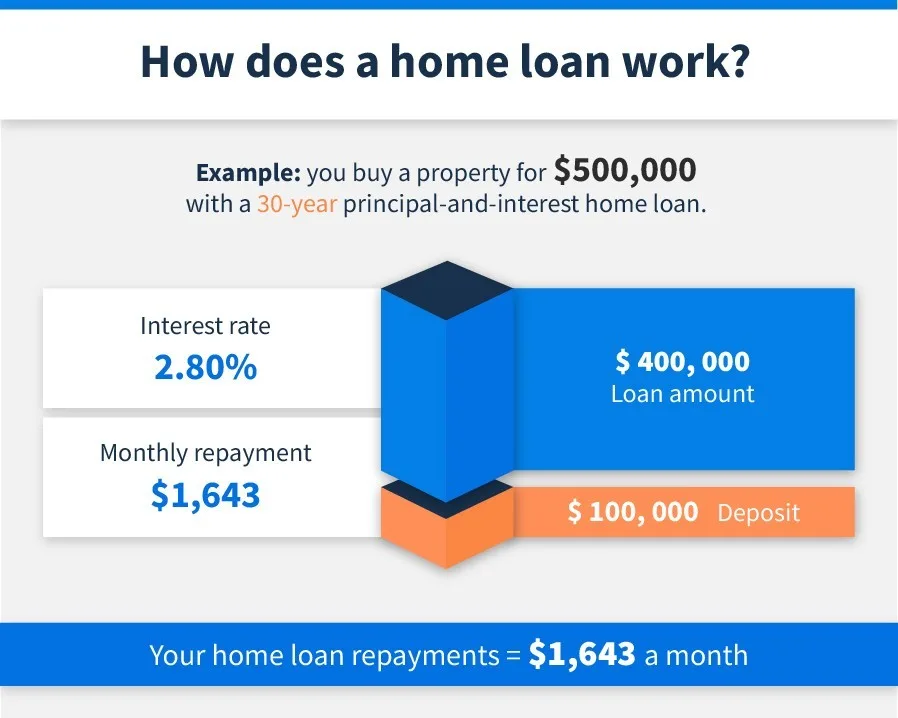Property costs a lot of money. So, instead of handing over a big wad of cash to pay for one, most people will take out a home loan.
You don't borrow the whole amount though. You'll save a deposit covering a certain amount of the property value (usually 5% to 20%) and you'll borrow the rest from a bank or other home loan lender.
Then, you make regular repayments back to the lender to slowly pay off the loan.
You won't just pay off the loan amount (also known as the principal). The lender will also charge you interest. Most people pick their home loans based on the lowest rate of interest, but that's not the only thing to look out for!
What is a home loan used for?
A home loan can be used to buy a property such as an apartment or a house. The property can be used to live in (owner-occupier) or to rent out (investment).
You can also take out a home loan to build a home. These are construction loans and are structured a little differently. You can use the loan simply to pay for the construction, or you can use the loan to buy the land you're building on as well. The loan will be split up so you receive portions of it at different points of the construction process.
More specialised home loans include loans line of credit loans and reverse mortgages.
Where do you get a home loan from?
The majority of Australians will get a home loan from a big bank like Commonwealth Bank, Westpac, ANZ or NAB. However, they are not the only places to get a home loan and are very often not the best places either.
Most other banks will also offer home loans, whether that's your second-tier lenders like ING or Bank of Queensland. But there are other places to get a home loan as well, and these are called non-bank lenders. Where a bank offers products in which you can keep your money (like a bank account), lenders offers loan products as their primary business. This is ok, there are some big names that do this, some of which are owned by a bank: Qantas, Kogan and Tiimely are examples of places you can get a home loan that aren't a bank.
How long do people pay a home loan for?
Loan terms used to be much shorter, but nowadays a first home loan is typically 30 years. It may be possible to work with your bank or lender to choose a different length loan term, which could be between 25 to 40 years. With some loans you are able to make extra repayments to pay your home loan off faster. A shorter loan term means you have higher repayments but you pay the loan off faster and pay less interest. A longer loan term will reduce what you pay in repayments, but you'll pay much more over the life of the loan.
Understanding home loan definitions
The deposit
Before taking out a home loan you'll need to pay a deposit. This will be a percentage of the property value, and the amount you borrow will cover the rest (see loan-to-value ratio below).
A typical aim for a deposit is 20% of the property value. But, you can also take out a loan with a 10% deposit or, in some cases, even a 5% deposit.
A smaller deposit is easier to achieve, but it means you borrow more money (in turn, paying more interest) and you'll need to pay something called Lender's Mortgage Insurance.

The interest rate
When you compare home loans, you'll see they have different interest rates.
This is the rate at which lenders will charge you for borrowing money from them. The higher the rate, the more expensive your loan will be.
Here's a simple example:
- You borrow $500,000 over 30 years, with an interest rate of 6.00%.
- Your monthly repayment = $2,998.
If the rate fell to 5.75%, your monthly repayments would be $2,918. That would save you $80 a month or $960 a year.
The rate of interest can vary depending on your credit history, how much you saved for your deposit, and the size of the loan.
Rate types: fixed and variable
Your interest rate will either be a fixed rate or a variable rate.
Loans with variable interest rates can change at any time, usually based on the Reserve Bank of Australia's cash rate. Variable rates typically offer more flexibility than fixed rates. There are no breaking costs associated with refinancing a variable rate loan, and these loans are more likely to come with features like extra repayments and offset accounts.
With a fixed rate loan you can lock in a specific interest rate for a period of time, typically between 1 and 5 years. This means you will know exactly what your repayments will be each month, because the rate won't change for the fixed period.
If your bank or lender increases their variable rate loans, your repayments won't be affected. This applies whether interest rates rise or fall. But you should note that there is less flexibility with options like extra repayments and less chance of features like an offset account.
If you're ready, you can compare which interest rate option is right for you.
The repayment type
Another decision you'll have to make is your loan's repayment type. You have 2 options:
- Principal-and-interest repayments. With a principal-and-interest home loan, you repay the money you have borrowed (the loan principal) plus the interest charges at the same time. You're paying off your debt and so you'll pay less interest in the long run.
- Interest-only repayments. With interest only repayments, you can avoid paying off any principal for an early period of the loan. Instead, you just pay the interest charges and ignore the loan principal. This makes your repayments cheaper, but eventually, you'll have to pay the loan back, and making interest only repayments for a while makes the overall loan more expensive.
Interest only loans are good options if you're buying an investment property as interest costs are tax deductible. Some owner occupiers choose to make interest-only repayments when they're having trouble covering repayments.
Here's an example of the difference between the 2 repayment types:
Principal and interest vs interest only repayments
Details | Principal and interest | Interest only |
|---|---|---|
Loan amount | $400,000 | $400,000 |
Loan term | 30 years | 30 years |
Interest rate | 6.00% | 6.00% |
Interest only period | N/A | 3 years |
Monthly repayments | $2,399 | $2,000 (during interest only period) $2,496 (after interest only period) |
Total loan cost over 30 years | $863,353 | $880,686 |
Difference in overall cost | $17,333 cheaper | $17,333 more expensive |
The loan purpose
The reason you need the home loan is going to determine the type of home loan you can apply for. If you're borrowing money to buy a home to live in you'll need an owner-occupier mortgage. If you're buying an investment property, you're looking for an investment loan.
Owner-occupier loans usually have lower interest rates than investment loans. In most other respects they're similar.
What features come with a home loan?
Home loans come with different features, which can make a big difference to how you can use them.
Extra repayments
You can often make extra repayments towards your loan to help you pay down the loan much faster. It's important to know that this is more common with variable rate loans. Some fixed rate loans do offer extra repayments, but often up to a certain amount. For example, a fixed rate loan may allow you to make maximum repayments of up $20,000 a year.
Redraw facilities
If you've been making extra repayments, and then you realise you need some extra cash for something else, you can withdraw from those extra repayments. Again, variable rates are much more flexible with this. Fixed rates may not allow redraw or they will have restrictions on how much you can redraw.
Offset accounts
Offset accounts are transaction accounts attached to your home loan. Any funds in the account are used to offset the interest you're charged. For example, if you place $10,000 in your offset account, and you have a loan amount of $350,000, your interest will be calculated on a loan amount of $340,000 rather than $350,000. Offset accounts usually give you complete access to your funds like any other transaction account. As with the extra repayments mentioned above, offset accounts can help you save a significant amount over the life of your loan.
Split facility
This type of home loan allows you to split your loan into a variable rate portion and fixed rate portion. A split facility is not a type of loan in itself, but a feature offered by lenders on some home loan products.
How do I get a home loan?
To get a home loan, you'll need to submit a home loan application. But before you do that, there are some steps to take.
For example, you should work out your borrowing power to know how much you can borrow. This not only avoids you applying for too much and being rejected, but gives you an idea of what properties you should be looking for.
You can then start comparing home loans by looking at interest rates, fees and features.
When you've found the right property and the right home loan for you, you'll fill in an application form for the home loan. The lender will process your application and make a decision on whether it will lend to you.
If you think you're ready for the next steps of applying for the home loan, we've got you covered with our step-by-step guide.
Ask a question
More guides on Finder
-
Mortgageport Home Loans
Mortgageport is a non-bank lender and mortgage manager, offering tailored home loan solutions for residents and non-residents.
-
WLTH home loans
For every home loan WLTH settles, it helps clean up 50sqm of beaches and coastline. It offers products for buyers, refinancers and investors.
-
Home loan cashback offers
Home loan cashback deals can help you refinance to a cheaper interest rate and get a lump sum cash payment. Compare the latest deals and check your eligibility today.
-
Current home loan interest rates in Australia
We compile the average home loan interest rates in the market and update them monthly.
-
Compare bank interest rates in May 2025
Compare current bank interest rates for home loans, credit cards, personal loans, savings accounts and term deposits to find the best deal for you.
-
Low deposit home loans
You may be able to get a low deposit home loan with just a 5% cash deposit. Here are the lenders who are more likely to lend you a 95% loan.
-
Investment home loan rates
The best investor home loan rates that have been offered in years have hit the market. Compare investment property loan rates today.
-
Cheap home loans – rates from 4.99%
Find the cheapest home loan rates and learn how to decide which one best fits your needs and will save you the most money.
-
Best variable home loan rates
Find a great deal on a variable interest rate home loan from lenders large and small. Start comparing and saving today.
-
Best home loan rates – 6 expert picks
Learn how to compare rates to find the best home loan and start saving money on your mortgage today.

